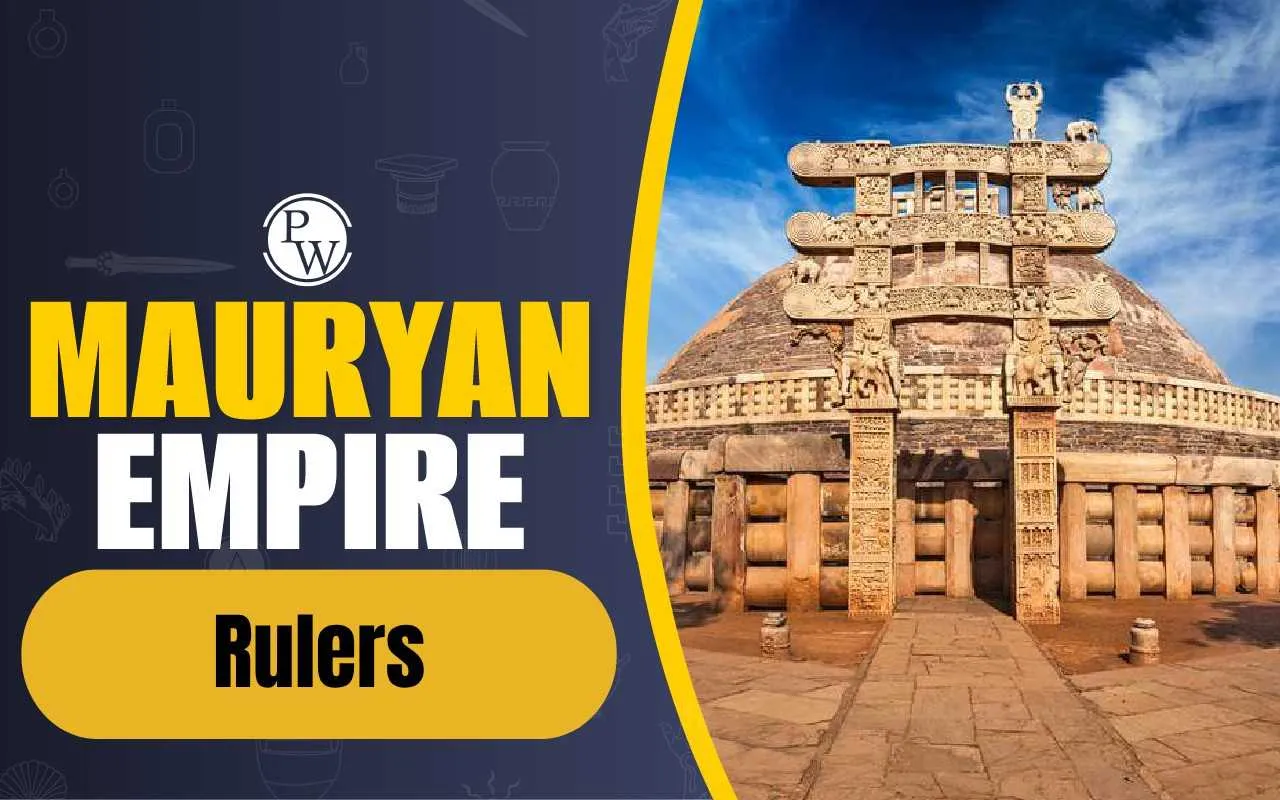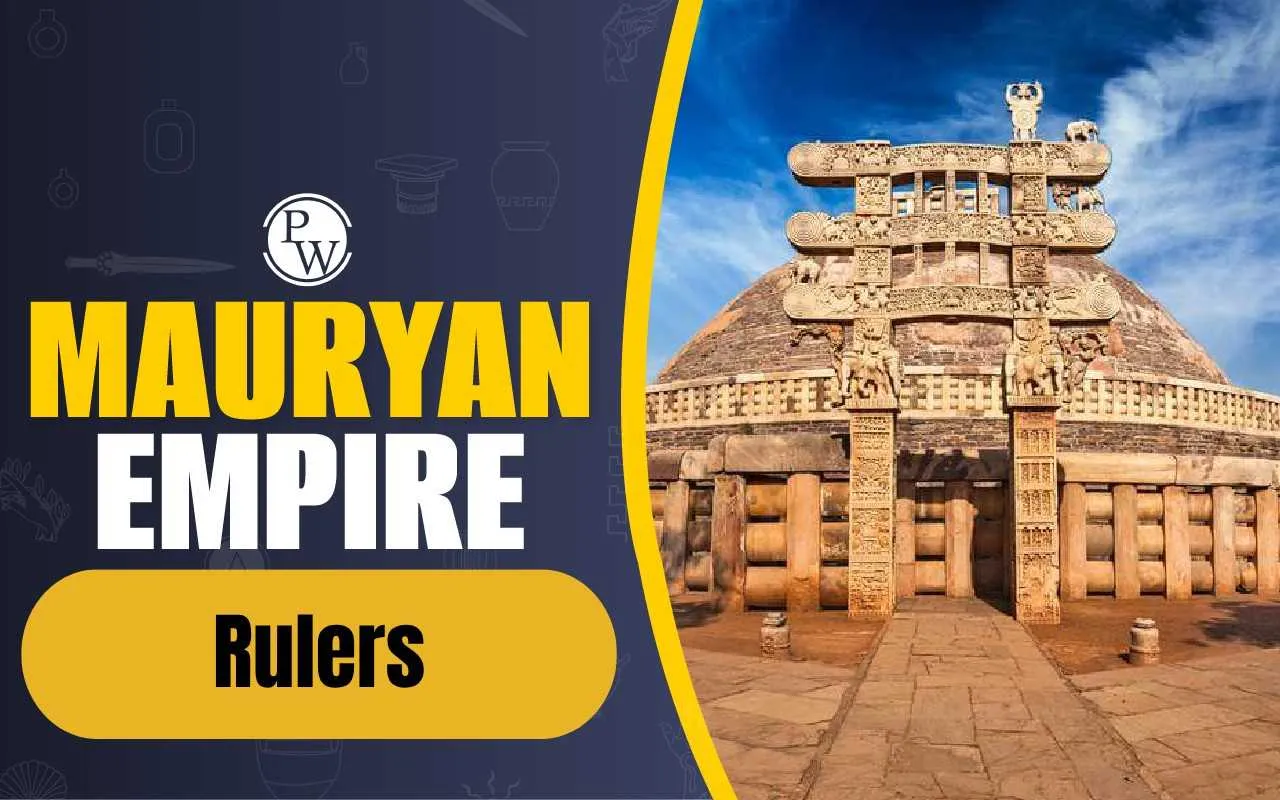

Mauryan Empire Rulers: The Mauryan Empire was one of the greatest and most powerful empires in ancient India. The Empire was renowned for its vast territory, administration, and great rulers. It began in 321 BCE and united most of the Indian subcontinent under one government.
Mauryan Empire rulers played an important role in creating India’s early political and cultural history. From Chandragupta Maurya, the first ruler of the Maurya dynasty, to Brihadratha, the last ruler of the Maurya dynasty, the achievements of each of these kings left a lasting impression on India’s ancient heritage.
Mauryan Empire Rulers Overview
Chandragupta Maurya founded the Mauryan Empire in 321 BCE. He established this empire under the guidance of his teacher and minister Kautilya. It was the first time that most of India came under one central rule.
Pataliputra, present-day Patna in Bihar, was the capital of the Mauryan Empire. The Mauryan rulers built roads, forts, and trade networks that connected several parts of the empire. The Mauryan Empire kings list includes the following:
-
Chandragupta Maurya
-
Bindusara
-
Ashoka the Great
-
Dasharatha Maurya
-
Samprati Maurya
-
Salisuka Maurya
-
Devavarman Maurya
-
Satadhanvan Maurya
-
Brihadratha Maurya
Mauryan Empire Rulers Timeline
The Mauryan Empire flourished for over 200 years, starting from 321 BCE under Chandragupta Maurya. He defeated the last Nanda ruler, Dhanananda and established the Mauryan Empire. A detailed timeline of the Mauryan Empire Rulers is provided in the table below:
| Mauryan Empire Rulers Timeline | |||
| Ruler | Period of Reign | Religion Followed | Achievements |
| Chandragupta Maurya | 321–297 BCE | Jainism (later life) |
|
| Bindusara | 297–273 BCE | Ajivika |
|
| Ashoka | 273–232 BCE | Buddhism |
|
| Dasharatha Maurya | 232–224 BCE | Buddhism |
|
| Samprati Maurya | 224–215 BCE | Jainism |
|
| Salisuka Maurya | 215–202 BCE | Hinduism (likely) |
|
| Devavarman Maurya | 202–195 BCE | Hinduism |
|
| Satadhanvan Maurya | 195–187 BCE | Hinduism |
|
| Brihadratha Maurya | 187–185 BCE | Hinduism |
|
Chandragupta Maurya
Chandragupta Maurya was the first ruler of Maurya dynasty and the founder of the empire. He overthrew the Nanda dynasty by defeating the last Nanda ruler, Dhanananda and established a new and powerful rule in Magadha.
-
Chandragupta Maurya was able to create a centralised government with organised provinces, and appointment of governors, and officials. Under his reign, Pataliputra became one of the most advanced cities in the world.
-
Some of the major achievements of Chandragupta Maurya are as follows:
-
He formed a large and disciplined Mauryan army.
-
He also established trade routes to improve business and economy.
-
Chandragupta Maurya also signed a peace treaty with Seleucus I of Greece.
-
Later on in his life, Chandragupta adopted Jainism and spent his final years meditating at Shravanabelagola, Karnataka.
Bindusara
Bindusara was the son of Chandragupta, who ruled the Mauryan empire from 297 to 273 BCE. He was the second in the Mauryan Empire rulers list.
-
He continued his father’s policy of territorial expansion. Greek history refers to him as Amitrochates, meaning “Slayer of Enemies.”
-
During the rule of Binduara:
-
The empire expanded to the Deccan region.
-
Peaceful relations were maintained with Greece and West Asia.
-
Administration became more efficient.
-
Bindusara was a follower of the Ajivika religion. The religion was known for its strict principles and belief in destiny.
Ashoka the Great
Ashoka was the most powerful ruler of Mauryan dynasty. He ruled from 273 to 232 BCE. Ashoka, the great, is one of the most respected emperors in world history.
-
In his early years, Ashoka was a fierce warrior who expanded his empire through several wars and conquests. However, the Kalinga War in 273 BCE deeply changed him.
-
The destruction and suffering caused due to the Kalinga War made Ashoka give up violence and adopt Buddhism.
-
From then on, Ashoka focused on compassion and welfare for his people. Some of the major contributions of Ashoka are as follows:
-
Promoted Buddhism across India and abroad.
-
Built stupas, viharas, and pillars with inscriptions teaching moral values.
-
Sent Buddhist monks to Sri Lanka, Nepal, and Southeast Asia.
-
Improved roads, hospitals, and shelters for people and animals
-
Under the reign of Ashoka, the empire reached its greatest territorial extent. The empire included almost all of India and parts of Afghanistan and Bangladesh.
Dasharatha Maurya
After Ashoka, his grandson Dasharatha Maurya became the ruler. His rule was short, and the empire began to weaken. Dasharatha was also a follower of Buddhism. He built several stupas and supported Buddhist institutions. However, regional uprisings and administrative divisions made it difficult for him to maintain full control.
Samprati Maurya
Samprati Maurya, another grandson of Ashoka, succeeded Dasharatha. He was known as a kind and peaceful ruler who followed Jainism. Samprati is remembered for spreading Jain teachings and constructing thousands of Jain temples across India. His reign brought temporary peace and stability to the empire.
Later Mauryan Rulers
After the reign of Samprati, several rulers ruled for short periods, including Salisuka, Devavarman, and Satadhanvan. The reign of the later Mauryan rulers was marked by internal conflicts and the gradual decline of central power. The empire started disintegrating into smaller kingdoms, and foreign invasions became frequent.
Brihadratha Maurya
Brihadratha Maurya was the last ruler of the Mauryan Empire. He ruled from 187 to 185 BCE. By the time he took the reins, the empire was already weakening.
-
Brihadratha was known for his gentle nature. However, he was unable to control his generals and provinces. His commander-in-chief, Pushyamitra Shunga, betrayed and killed him during a military parade.
-
After his death, the Shunga Dynasty took over, marking the end of the Mauryan Empire.
Mauryan Dynasty Family Tree
The Maurya dynasty family tree demonstrates the transfer of power from one ruler to another. It began with Chandragupta Maurya, the founder, and ended with Brihadratha Maurya, the last emperor. The Mauryan Empire rulers names in order is provided below:
-
Chandragupta Maurya – Founder and first ruler of Maurya dynasty
-
Bindusara – Son of Chandragupta Maurya
-
Ashoka the Great – Son of Bindusara and a powerful ruler of the Maurya dynasty
-
Dasharatha Maurya – Grandson of Ashoka
-
Samprati Maurya – Grandson of Ashoka
-
Salisuka Maurya
-
Devavarman Maurya
-
Satadhanvan Maurya
-
Brihadratha Maurya – Last ruler of the Maurya dynasty
Maurya Dynasty Rulers Religion Wise
The Maurya dynasty rulers religion wise were known to be diverse. It showcased how the Mauryan rulers respected different faiths and promoted religious tolerance in the empire.
-
Chandragupta Maurya – Adopted Jainism in later life.
-
Bindusara – Believed in the Ajivika philosophy.
-
Ashoka – Followed Buddhism after the Kalinga War.
-
Dasharatha Maurya – Practised Buddhism.
-
Samprati Maurya – Devout Jain.
-
Later rulers – Followed Hinduism.
Achievements and Legacy of the Mauryan Empire Rulers
The Mauryan Empire rulers names were renowned for their efficient administration and important contributions. Their achievements made it possible for later kingdoms to follow the cue and establish efficient empires. Some of the important achievements of the Mauryan Empire Rulers are as follows:
-
Political Unity: They united most of India under one rule.
-
Efficient Administration: The empire had a strong system of governance.
-
Cultural Growth: Art, architecture, and literature flourished.
-
Religious Harmony: Different religions were respected.
-
Economic Prosperity: Trade, agriculture, and taxation improved the economy.
